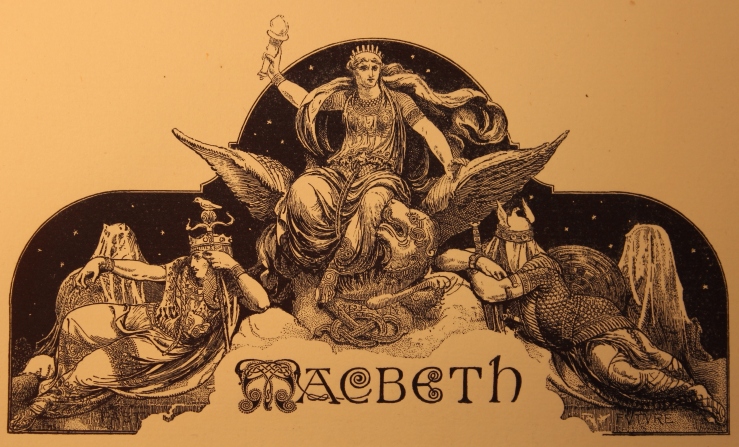
Shakespeare’s Macbeth is a bloodthirsty tale of ambition, treachery and aggression, one which resonates with the Library of Birmingham’s season of ‘Voices of War’. To coincide with the library’s wonderful exhibition: ‘Voices of War: Birmingham People 1914 – 1918’, the Collection Curators at the Library of Birmingham are holding a public display of some of the art work from this great story to highlight the extensive Shakespeare collection, the second largest in the world behind the Folger Library in Washington.
This free event will be held on Saturday 1 November, 12.00 – 2.00 in the Heritage Learning Suite on Floor 4 of the Library of Birmingham.
‘Macbeth and War’
The play opens with three witches, described by Banquo, friend to Macbeth, as “So withered and so wild in attire, that look not like th’ inhabitants o’ th’ earth and yet are on ‘t? – Live you?” (Act I, Scene II)
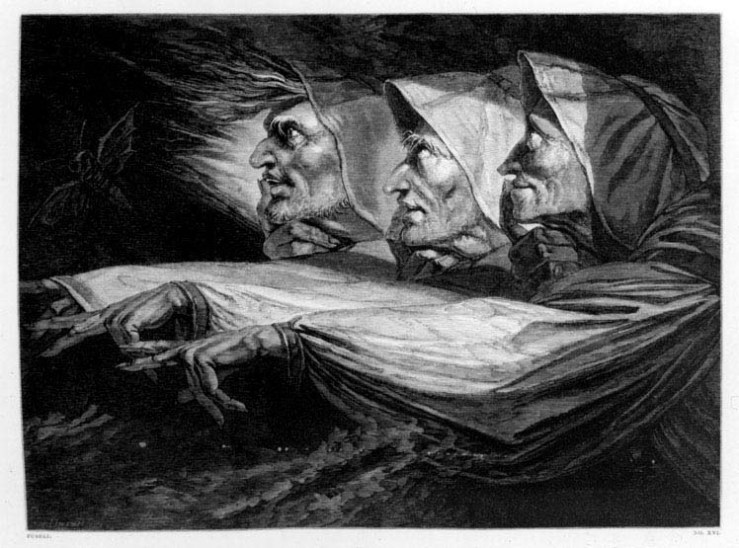
The witches arrange to meet Macbeth, who is fighting a great and bloody battle against the allied forces of Norway and Ireland. When they meet the witches give them three predictions: that Macbeth will become Thane of Cawdor, that he will be the King of Scotland, and Banquo’s descendants will also become kings.
Macbeth relays these prophesies to his wife, Lady Macbeth, and between them they go on a spree of treachery and murder, invoking evil spirits to achieve their perceived covetous right.
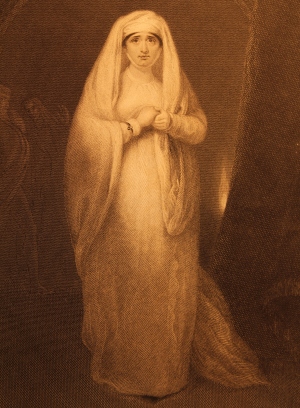
Due to his war heroics Macbeth is proclaimed Thane of Cawdor by King Duncan but to enact the prophesies Macbeth and Lady Macbeth need to remove the King from his position. Whilst Macbeth’s loyalty to the King causes him to deliberate with killing King Duncan, his masculinity is questioned by Lady Macbeth who goads him into action. Macbeth states that “We will proceed no further in this business. He hath honoured me of late and I have bought golden opinions from all sorts of people, which would be worn now in their newest gloss, not cast aside so soon” (Act I, Scene VII) to which Lady Macbeth responds: “What beast was’t, then, that made you break this enterprise to me, then you were a man; and to be more than what you were, you would be so much more than man” (Act I, Scene VII). Helped on by this verbal onslaught Macbeth kills King Duncan via a plan hatched by his wife.
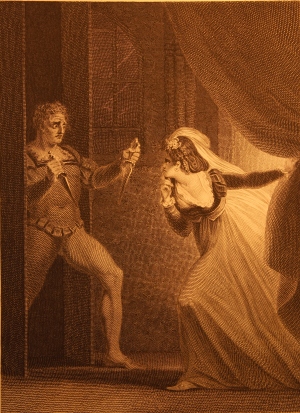
Macbeth ascends to the throne but with the realisation that the second prediction from the witches has come true, he is now in fear of the third prediction, that Banquo’s descendants will also be kings. Macbeth therefore decides to kill Banquo and his son, Fleance, but the ghastly deed does not go as planned, Banquo is killed but Fleance escapes the murderers.
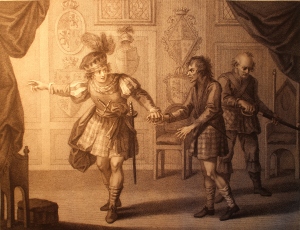
Attending a royal feast with tables laden with food, Macbeth goes to sit at the head of the royal table but finds Banquo’s ghost sitting in his chair. With no-one else able to see the apparition Macbeth believes he is going mad.
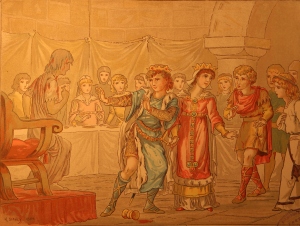
Macbeth again visits the witches to ask them to reveal the truth of their prophecies. The witches circle their bubbling cauldron, chanting spells and adding strange ingredients to their brew: “eye of newt and toe of frog, wool of bat and tongue of dog, adder’s fork and blind-worm’s sting, lizard’s leg and owlet’s wing, for a charm of powerful trouble, like a hell-broth boil and bubble” (Act IV Scene I).
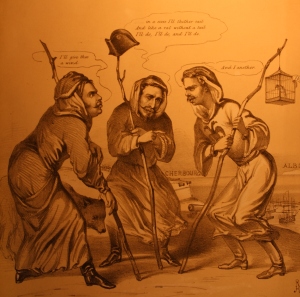
To answer his questions the witches reveal to Macbeth horrible apparitions. The first is a floating head warning him to beware of Macduff to which Macbeth responds that he has already guessed as much. The second is a bloody child which states that “none of woman born shall harm Macbeth” (Act IV Scene I). Next, a crowned child holding a tree tells him that he is safe until ‘Birnam Wood’ moves to Dunsinane Hill, the royal castle. The last apparition is of a procession of eight crowned kings, the last holding a mirror. Banquo’s ghost walks at the end of the line. Macbeth demands to know the meaning of this final vision, but the three witches perform a bizarre dance and vanish from view.
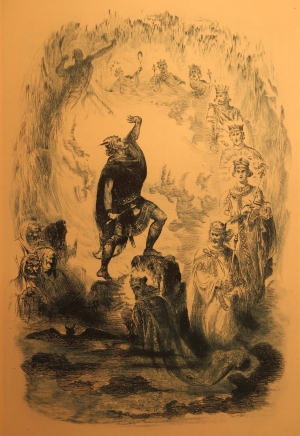
Macbeth becomes more ruthless and blood thirsty, killing the family of Lord Macduff, whom he has been told has fled to England to amass troops to fight against him. Lady Macbeth, wreaked with guilt about King Duncan, becomes deranged, having “thick-coming fancies” (Act 5, Scene 3) and news comes to Macbeth via a messenger that she is dead.
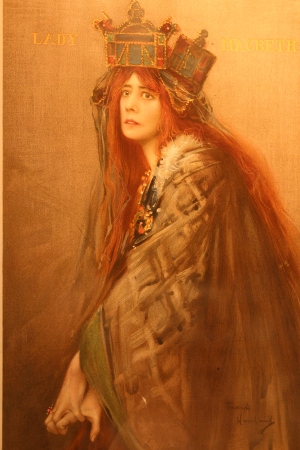
Near Birnam Wood a large army masses and Macbeth plans to defend the fortified castle. The soldiers each take a branch from trees in the wood and together they march to the castle, thereby disguising their numbers.
Macduff finds Macbeth and a spirit relates to him that Macduff was born by a caesarean, “Macduff was from his mother’s womb, untimely ripped. (Act 5, Scene 8)”. The final two predictions by the witches, that Birnam Wood’ moves to Dunsinane Hill and none of woman born shall harm Macbeth come to pass and Macbeth is slain by Macduff.
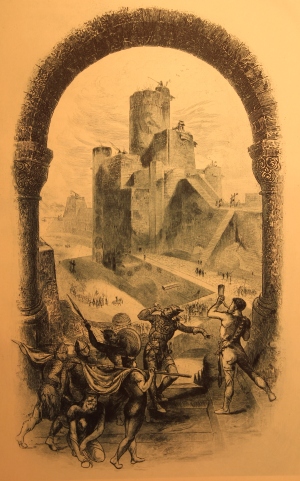
The tale highlights that the manner of Macbeth’s kingship, one of tyranny and without legitimacy, as it is not based on loyalty to the state, is the worst possible and that true kingship can only be one motivated by love of the kingdom more than by pure self-interest.
The free event ‘Macbeth and War’ will be held on Saturday 1 November, 12.00 – 2.00 in the Heritage Learning Suite on Floor 4 of the Library of Birmingham.
All are welcome though queues may be possible.
Phil Burns, Collection Curator, Library of Birmingham
